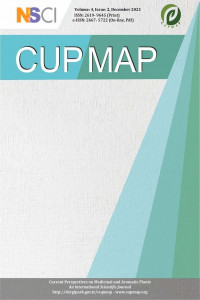Abstract
References
- Ałtyn, I., and Twarużek, M., 2020. Mycotoxin Contamination Concerns of Herbs and Medicinal Plants. Toxins. 12(3). doi: 10.3390/toxins12030182.
- Aziz, M.A., Khan, A.H., Adnan, M., and Ullah, H., 2018. Traditional uses of medicinal plants used by Indigenous communities for veterinary practices at Bajaur Agency, Pakistan. J Ethnobiol Ethnomedicine. 14(1):11. doi: 10.1186/s13002-018-0212-0.
- BenJemaa, M., Falleh, H., Neves, M.A., Isoda, H., Nakajima, M., and Ksouri, R., 2017. Quality preservation of deliberately contaminated milk using thyme free and nanoemulsified essential oils. Food Chemistry. 217: 726-734. doi: 10.1016/j.foodchem.2016.09.030.
- BenJemaa, M., Hafsi, C., Falleh, H., Serairi Beji, R., and Ksouri, R., 2021. Essential Oils As Food Preservative: Encapsulation, Biological Activities, And Sensory Impact. In: The Seventh International Mediterranean Symposium on Medicinal and Aromatic Plants. ISBN: 978-605-61261-9-2.
- Dewanto, V., Wu, X., and Liu, R.H., 2002. Thermal Processing Enhances the Nutritional Value of Tomatoes by Increasing Total Antioxidant Activity. Journal of agriculture and food chemistry. 14,50(17):4959-64. doi:10.1021/jf0115589
- Jeske, S., Zannini, E., and Arendt, E.K., 2017. Evaluation of Physicochemical and Glycaemic Properties of Commercial Plant-Based Milk Substitutes. Plant Foods for Human Nutrition. 72(1):26‑33. doi: 10.1007/s11130-016-0583-0.
- Mäkinen, O.E., Wanhalinna, V., Zannini, E., and Arendt, E.K., 2016. Foods for Special Dietary Needs: Non-dairy Plant-based Milk Substitutes and Fermented Dairy-type Products. Critical Reviews in Food Science and Nutrition. 56(3):339‑49. doi: 10.1080/10408398.2012.761950.
- McNees, A.L., Markesich, D., Zayyani, N.R., and Graham, D.Y., 2015. Mycobacterium paratuberculosis as a cause of Crohn’s disease. Expert Review of Gastroenterology & Hepatology. 9(12):1523‑34. doi: 10.1586/17474124.2015.1093931.
- Munekata, P.E.S., Domínguez, R., Budaraju, S., Roselló-Soto, E., Barba. F.J., and Mallikarjunan, K., 2020. Effect of Innovative Food Processing Technologies on the Physicochemical and Nutritional Properties and Quality of Non-Dairy Plant-Based Beverages. Foods Basel Switz. 9(3). doi: 10.3390/foods9030288.
- Paul, A.A., Kumar, S., Kumar, V., and Sharma, R., 2020. Milk Analog: Plant based alternatives to conventional milk, production, potential and health concerns. Critical Reviews in Food Science and Nutrition. 60 (18):3005‑23. doi: 10.1080/10408398.2019.1674243.
- Sethi, S., Tyagi, S.K., and Anurag, R.K., 2016. Plant-based milk alternatives an emerging segment of functional beverages: a review. Journal of Food Science and Technology. 53(9):3408‑23. doi: 10.1007/s13197-016-2328-3.
- Silva, A.R.A., Silva, M.M.N., and Ribeiro, B.D., 2020. Health issues and technological aspects of plant-based alternative milk. Food Research International. 131:108972. doi:10.1016/j.foodres.2019.108972
- Siri-Tarino, P.W., Sun, Q., Hu, F.B., and Krauss, R.M., 2010. Saturated fat, carbohydrate, and cardiovascular disease. American Journal of Clinical Nutrition. 91(3):502‑9. doi: 10.3945/ajcn.2008.26285.
- Smedman, A., Lindmark-Månsson, H., Drewnowski, A., and Edman, A-K.M., 2010. Nutrient density of beverages in relation to climate impact. Food and Nutrition Research. 54. doi: 10.3402/fnr.v54i0.5170.
- Tapsell, L.C., Hemphill, I., Cobiac, L., Patch, C.S., Sullivan, D.R., and Fenech, M., 2006. Health benefits of herbs and spices: the past, the present, the future. The Medical Journal of Australia. 185(S4):S1‑24. doi: 10.5694/j.1326-5377.2006.tb00548.x.
- Thorning, T.K., Raben, A., Tholstrup, T., Soedamah-Muthu, S.S., Givens, I., and Astrup, A., 2016. Milk and dairy products: good or bad for human health? An assessment of the totality of scientific evidence. Food and Nutrition Research. 60:32527. doi: 10.3402/fnr.v60.32527.
- Vanga, S.K., and Raghavan, V., 2018. How well do plant based alternatives fare nutritionally compared to cow’s milk? Journal of Food Science and Technology. 55(1):10‑20. doi: 10.1007/s13197-017-2915-y.
- Wu, G., 2016. Dietary protein intake and human health. Food and Function. 7(3):1251‑65. doi: 10.1039/c5fo01530h.
- Yada, S., Lapsley, K., and Huang, G., 2011. A review of composition studies of cultivated almonds: Macronutrients and micronutrients. Journal of Food Composition Analysis. 24(4):469‑80. doi: 10.1016/j.jfca.2011.01.007.
Plant-Based Milk Alternative: Nutritional Profiling, Physical Characterization and Sensorial Assessment
Abstract
The aim of this work was the characterization of four plant-based milks: oat, almond, hemp, and quinoa’s milk. The nutritional composition of each milk, as well as its physico-chemical characteristics, microbiologic stability, and antioxidant potential, were determined in order to investigate the effect of the first ingredient on the overall quality of the plant-based milk. Finally, a hedonic sensory analysis was conducted in order to determine the acceptability of these products. In terms of nutritional value, obtained results highlighted that oat’s milk has the highest carbohydrate, protein and fiber contents (23g/100ml, 5g/100ml and 3g/100ml, respectively). However, hemp’s milk has the highest fat and calcium content (7g/100ml and 37.5 mg/ 100 ml, respectively). The pH of tested plant-based milk, were all similar and close to neutrality. The WI values found were 21.46 for almond’s milk, 9.48 for oat’s milk, 34.97 for hemp’s milk, and 0.1 for quinoa’s milk. The antioxidant capacity assessment demonstrated that tested plant-based milk have an interesting potential. Measured inhibition capacities ranged from 78.34 % (quinoa’s milk) to 63.14 % (oat’s milk), and their total polyphenol content ranged from 0.310 mg EAG/g DM (oat’s milk) to 0.836 mg EAG/g DM (quinoa’s milk). The microbial stability results showed that quinoa’s milk had the best bacterial stability, with a maximum denomination of 56 *104 UFC/ml for the first 8 days of storage, while almond and oat’s milks had better fungal stability and were free of contaminants up to the eighth day of storage. During the hedonic sensory analysis, the almond’s milk was the most appreciated by the panelist. Gathered results suggest that plant-based milks are high in nutrients and phenolic compounds, and they deserve to be considered as “healthy aliment”.
References
- Ałtyn, I., and Twarużek, M., 2020. Mycotoxin Contamination Concerns of Herbs and Medicinal Plants. Toxins. 12(3). doi: 10.3390/toxins12030182.
- Aziz, M.A., Khan, A.H., Adnan, M., and Ullah, H., 2018. Traditional uses of medicinal plants used by Indigenous communities for veterinary practices at Bajaur Agency, Pakistan. J Ethnobiol Ethnomedicine. 14(1):11. doi: 10.1186/s13002-018-0212-0.
- BenJemaa, M., Falleh, H., Neves, M.A., Isoda, H., Nakajima, M., and Ksouri, R., 2017. Quality preservation of deliberately contaminated milk using thyme free and nanoemulsified essential oils. Food Chemistry. 217: 726-734. doi: 10.1016/j.foodchem.2016.09.030.
- BenJemaa, M., Hafsi, C., Falleh, H., Serairi Beji, R., and Ksouri, R., 2021. Essential Oils As Food Preservative: Encapsulation, Biological Activities, And Sensory Impact. In: The Seventh International Mediterranean Symposium on Medicinal and Aromatic Plants. ISBN: 978-605-61261-9-2.
- Dewanto, V., Wu, X., and Liu, R.H., 2002. Thermal Processing Enhances the Nutritional Value of Tomatoes by Increasing Total Antioxidant Activity. Journal of agriculture and food chemistry. 14,50(17):4959-64. doi:10.1021/jf0115589
- Jeske, S., Zannini, E., and Arendt, E.K., 2017. Evaluation of Physicochemical and Glycaemic Properties of Commercial Plant-Based Milk Substitutes. Plant Foods for Human Nutrition. 72(1):26‑33. doi: 10.1007/s11130-016-0583-0.
- Mäkinen, O.E., Wanhalinna, V., Zannini, E., and Arendt, E.K., 2016. Foods for Special Dietary Needs: Non-dairy Plant-based Milk Substitutes and Fermented Dairy-type Products. Critical Reviews in Food Science and Nutrition. 56(3):339‑49. doi: 10.1080/10408398.2012.761950.
- McNees, A.L., Markesich, D., Zayyani, N.R., and Graham, D.Y., 2015. Mycobacterium paratuberculosis as a cause of Crohn’s disease. Expert Review of Gastroenterology & Hepatology. 9(12):1523‑34. doi: 10.1586/17474124.2015.1093931.
- Munekata, P.E.S., Domínguez, R., Budaraju, S., Roselló-Soto, E., Barba. F.J., and Mallikarjunan, K., 2020. Effect of Innovative Food Processing Technologies on the Physicochemical and Nutritional Properties and Quality of Non-Dairy Plant-Based Beverages. Foods Basel Switz. 9(3). doi: 10.3390/foods9030288.
- Paul, A.A., Kumar, S., Kumar, V., and Sharma, R., 2020. Milk Analog: Plant based alternatives to conventional milk, production, potential and health concerns. Critical Reviews in Food Science and Nutrition. 60 (18):3005‑23. doi: 10.1080/10408398.2019.1674243.
- Sethi, S., Tyagi, S.K., and Anurag, R.K., 2016. Plant-based milk alternatives an emerging segment of functional beverages: a review. Journal of Food Science and Technology. 53(9):3408‑23. doi: 10.1007/s13197-016-2328-3.
- Silva, A.R.A., Silva, M.M.N., and Ribeiro, B.D., 2020. Health issues and technological aspects of plant-based alternative milk. Food Research International. 131:108972. doi:10.1016/j.foodres.2019.108972
- Siri-Tarino, P.W., Sun, Q., Hu, F.B., and Krauss, R.M., 2010. Saturated fat, carbohydrate, and cardiovascular disease. American Journal of Clinical Nutrition. 91(3):502‑9. doi: 10.3945/ajcn.2008.26285.
- Smedman, A., Lindmark-Månsson, H., Drewnowski, A., and Edman, A-K.M., 2010. Nutrient density of beverages in relation to climate impact. Food and Nutrition Research. 54. doi: 10.3402/fnr.v54i0.5170.
- Tapsell, L.C., Hemphill, I., Cobiac, L., Patch, C.S., Sullivan, D.R., and Fenech, M., 2006. Health benefits of herbs and spices: the past, the present, the future. The Medical Journal of Australia. 185(S4):S1‑24. doi: 10.5694/j.1326-5377.2006.tb00548.x.
- Thorning, T.K., Raben, A., Tholstrup, T., Soedamah-Muthu, S.S., Givens, I., and Astrup, A., 2016. Milk and dairy products: good or bad for human health? An assessment of the totality of scientific evidence. Food and Nutrition Research. 60:32527. doi: 10.3402/fnr.v60.32527.
- Vanga, S.K., and Raghavan, V., 2018. How well do plant based alternatives fare nutritionally compared to cow’s milk? Journal of Food Science and Technology. 55(1):10‑20. doi: 10.1007/s13197-017-2915-y.
- Wu, G., 2016. Dietary protein intake and human health. Food and Function. 7(3):1251‑65. doi: 10.1039/c5fo01530h.
- Yada, S., Lapsley, K., and Huang, G., 2011. A review of composition studies of cultivated almonds: Macronutrients and micronutrients. Journal of Food Composition Analysis. 24(4):469‑80. doi: 10.1016/j.jfca.2011.01.007.
Details
| Primary Language | English |
|---|---|
| Subjects | Food Engineering |
| Journal Section | Research Articles |
| Authors | |
| Publication Date | December 30, 2021 |
| Published in Issue | Year 2021 Volume: 4 Issue: 2 |
Cited By
-------------------------------------------------------------------------------------------------------------------------------













-------------------------------------------------------------------------------------------------------------------------
 CUPMAP Journal is licensed under a Creative Commons Attribution-NonCommercial-NoDerivatives 4.0 International License.
CUPMAP Journal is licensed under a Creative Commons Attribution-NonCommercial-NoDerivatives 4.0 International License.
-----------------------------------------------------------------------------------------------------------------------------------------
This is an open access journal which means that all content is freely available without charge to the user or his/her institution. Users are allowed to read, download, copy, distribute, print, search, or link to the full texts of the articles, or use them for any other lawful purpose, without asking prior permission from the publisher or the author. This is in accordance with the BOAI definition of open access.

